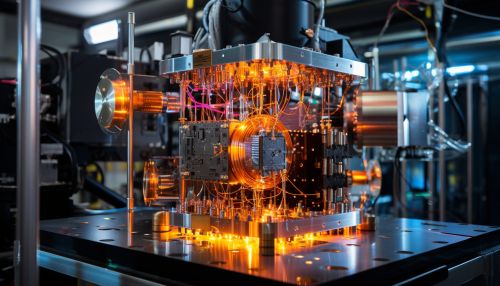Quantum Computing with Quantum Optomechanical Systems in the Study of Quantum Theory
Introduction
Quantum computing is a rapidly evolving field that leverages the principles of quantum mechanics to process information. One of the promising avenues in this field is the use of quantum optomechanical systems, which combine the properties of light (optics) and mechanical motion at the quantum level. This article delves into the intricate details of quantum computing with quantum optomechanical systems in the context of quantum theory.


Quantum Computing
Quantum computing is a computation paradigm that uses quantum bits (qubits) instead of classical bits for processing information. Unlike classical bits, which can be either 0 or 1, qubits can exist in a superposition of states, allowing them to perform multiple calculations simultaneously. This property, along with entanglement and quantum interference, gives quantum computers their computational power.
Quantum Optomechanical Systems
Quantum optomechanical systems are physical systems where the motion of a mechanical object is coupled to the state of a light field. These systems can be used to study a variety of quantum phenomena, including quantum entanglement, quantum superposition, and quantum measurement. They also have potential applications in quantum information processing, including quantum computing.
Quantum Theory
Quantum theory, or quantum mechanics, is the theoretical framework that describes the behavior of particles at the quantum level. It introduces concepts such as wave-particle duality, uncertainty principle, and quantum superposition, which are fundamental to understanding quantum computing.
Quantum Computing with Quantum Optomechanical Systems
Quantum optomechanical systems can be used in quantum computing to manipulate and store quantum information. The interaction between light and mechanical motion in these systems can be exploited to create qubits, perform quantum gates, and implement quantum error correction.


Quantum Optomechanical Systems in Quantum Theory
Quantum optomechanical systems provide a unique platform for studying quantum theory. They allow for the exploration of quantum phenomena in a macroscopic context, bridging the gap between the quantum and classical worlds. They also offer insights into quantum decoherence, the process by which quantum systems lose their quantum properties due to interaction with the environment.
Conclusion
Quantum computing with quantum optomechanical systems offers a promising path towards the realization of practical quantum computers. By leveraging the unique properties of these systems, researchers are able to explore the intricacies of quantum theory and push the boundaries of quantum information processing.
